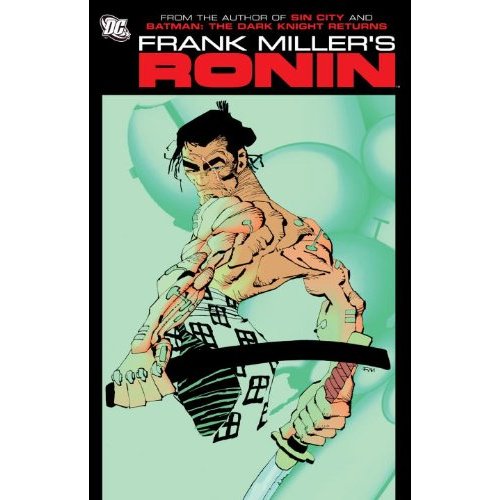
FMR
Frank Miller’s Ronin – When this six-issue was first published in 1982 by DC, and when I was a pretty firm Marvel fan, I bought it anyway, probably based on Miller’s reputation with Daredevil and the Wolverine mini-series. I caught up with it from Issue 3 and quickly became fascinated with the weird dual storyline (medieval Japan contrasted with an apocalyptic near-future of New York) and the strange scratchy drawing style Miller employs here, creating bevelled human faces alongside trippy sketches of urban cityscapes, not to mention artistic explorations of the grime and anarchy of the rotten underworld inhabited by Nazis, criminal gangs and other assorted devolved crazies. This is a world of civilisation, but also one balanced by the senseless violence and chaos of the human drama – decapitations, arms sliced off, black eyes, cannibalism, an evil computer (very HAL 2000), a bit of sex and drugs… and of course rivers of blood and lots of destruction (mayhem may be common in today’s comics, but this is the first really gory comic that I can remember). It’s a very cinematographic comic as Miller incorporates Kurosawa’s samurai films, Escape From New York, 2001 A Space Odyssey, Robocop, The Warriors, and many other films, as well as the Akira manga.
The book starts off in old Tokyo, with our samurai and his master. The master is killed by his enemy, the demon Agat, turning our young samurai into a ronin set on his master’s revenge. In a brilliant move, the ronin destroys himself and his enemy, but the demon has one more trick up his sleeve – to trap both of them in the sword.
But all of this is just a staging scene for the real story, set in the last 21st century when the world is as war, society has collapsed and polarised completely. This is the world of Billy Challas, an armless legless boy with psychic abilities, who lives alongside descendants of ours who cope daily with the mistakes we are going to make, some of whom live and work in the Aquarius Corporation with its fortified compound, managed/ruled by corporate types and administered by an intelligent CPU called Virgo. With anarchy outside of its walls, security is a high concern – keeping the outside out and the inside in. The world is explained in the opening pages, with updates hinted at throughout the book, but what doesn’t become apparent immediately is that the dangers within Aquarius may actually be greater than those without. This sense of dread builds throughout the story.
The real magic of the story is in its design and its layout, as well as its storytelling techniques. Ronin, in one silent sequence, tames a wild horse in Central Park while local crazies watch from the bushes. Another sequence is told in pitch dark, with Miller using word balloons to help the characters (and the readers) learn what is happening. Then there are the tight panels where Peter McKenna we observe McKenna’s thinking process as he intuits what has undergone in Aquarius and who the real movers are. There’s also an amazing panel when Taggert/Agat learns that he’s probably the figment of someone’s imagination. Many pages are full of panels that offer no dialogue or sound whatsoever – a fight scene here, a love scene there – offering fluid storytelling through images; these are balanced by others that are absolutely cluttered with word balloons to provide extensive background and updates. There are also plenty of amazing two-page spreads that demonstrate the destruction of the world, along with its rebirth through the growth of the plastic bio-circuitry created by McKenna (the rounded bio-circuitry forms a neat contrast with the edges and corners of existing architecture, and also magically seems to be part of both the foreground and the background). One particular series shows the same neighborhood as it evolves.